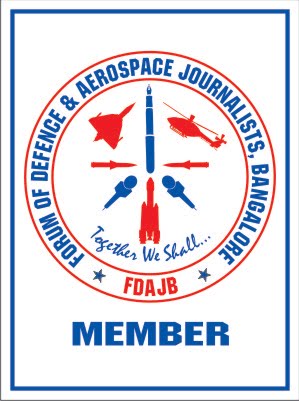(Press Release)
The maritime reconnaissance on the West coast got a boost today with the commissioning of an Unmanned Aerial Vehicle (UAV) Squadron at the Naval Air
Enclave, Porbander by Her Excellency the Governor of Gujarat, Dr. Shrimati Kamla. Designated as INAS 343, this is the first Operational UAV Squadron under the Western Naval Command. This UAV squadron positioned at Porbandar will enhance the maritime surveillance and coastal security in this region.
Capable of beaming real time live pictures of maritime targets to commands ashore, these UAVs will enhance the joint war waging capability in the region by synergizing capabilities of Army, Air Force, Coast Guard and local authorities. The commissioning of INAS 343 is a short in the arm for the Western Naval Command enhancing its capability and reach in the maritime frontiers. The formation of this squadron at Porbandar is of utmost relevance and allows the Indian Navy to patrol the Northern portion of the Arabian Sea . The location is ideal for covering the Sea Lanes of Communication (SLOCs) coming from the Gulf as well as providing surveillance cover to high value assets on Western Coast.
Her Excellency the Governor of Gujarat, Dr Shrimati Kamla was received at the Naval Air Enclave, Porbander, by Vice Admiral Sanjeev Bhasin, Flag Officer Commanding-in-Chief, Western Naval Command. The Governor was presented a 50-man ceremonial Guard of Honour. The ceremony commenced with the recitation of a Sanskrit invocation from the Atharva Veda followed by unveiling the Commissioning plaque by the Governor. The Commanding Officer of the INAS 343, Commander Atulya Dayal read out the Commissioning Warrant. With the hoisting of the Naval Ensign and the breaking of the Commissioning pennant, the INAS 343 Squadron was formally commissioned in the Indian Navy.
Addressing the gathering after commissioning the INAS 343 Squadron, the Governor said that a powerful Navy should be regarded as an appropriate and natural means of power projection, deterrence and national defence. “The Navy has kept our coastline and vast expanse of ocean territory safe and secure over the years. The last decade has seen the Navy’s reach expand and it is now operating at ever extending ranges from our shores” she said. Dedicating the new UAV Squadron INAS 343, nicknamed ‘Frontier Formidables’, she stated that the induction of these assets into Gujarat will help secure our maritime boundaries as well as our shipping lanes and territorial waters besides making the 1600 Kms coastline of Gujarat,(longest among coastal states) with a large number of high value and critical national assets, more secure and tranquil.
In 2002, the Indian Navy procured the Maritime versions of Searcher MK II and Heron from Israel. In 2003, post training of operator crew in Israel Kochi 06th Jan 2006 as INAS 342. This Squadron has a dual task of undertaking operational missions besides providing training. Since their induction, the UAVs’ have taken part in all major exercises of the Indian Navy. The efficacy and usefulness of this aircraft has been proven time and again.
‘Searcher’ is a third generation UAV, capable of carrying modern and sophisticated Electro Optic Camera and Electronic Support Measure (ESM) or Communication Intelligence (COMINT) payload. It is a relatively small aircraft with a wing span of about 8.5 m. ‘Heron’ is the bigger version of Searcher MK II which can carry heavy payloads including a Maritime Patrol Radar (MPR) and has a wing span of about 16 m. This makes it an ideal maritime reconnaissance aircraft.
Most of the world’s developed nations are actively pursuing UAV programmes which show its importance in the current scenario. UAV development is fast overtaking manned aircraft production owing to its relatively risk free operations and enhanced ranges and endurance. Armed UAVs are also in use and being further developed. India























